Ducks are sometimes overlooked for their beauty, but without question among the most colorful and dramatically feathered birds in North America, and in the world, are drake Wood Ducks. If an artist conjured up such a bird it would be unbelievable if you hadn’t seen one before in the wild. But an artist’s oils, watercolors, and other media all fall short of capturing the true essence of a male Wood Duck’s iridescent plumage as sunlight plays its magic on individual elements of its feathers, showing remarkable depth and color quality. That’s where a camera’s image provides the ultimate reproduction of the reflective qualities and shining coloration of a Wood Ducks’ plumage.
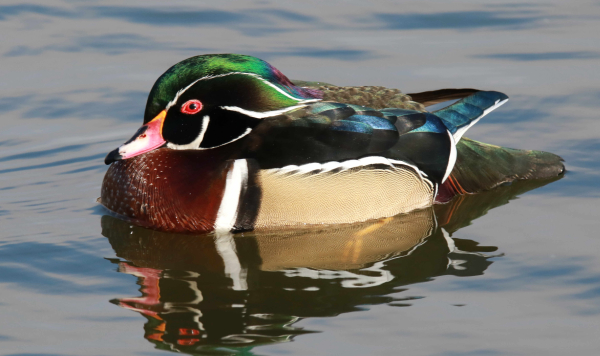
You can almost feel the cold as this colorful Wood Duck holds its head and neck close to its body, although it has its body feathers puffed up to hold a layer of body-heated air beneath them. The drake’s iridescent feathers are illuminated by full winter sunlight.
Only a camera can reproduce the true potential of the coloration of many ducks, and our digital media provides the best quality of reproduction available to date. But to create those inherent colors we need sunlight coming from our backside to illuminate the ducks before us.
Although I live in one of the best areas for migrating and nesting ducks in North America, during winter all ducks have vacated the frozen marshes save for a few open-water areas along the Missouri River. Farther south, a few more backwater bays stay open longer, attracting the hardiest of ducks that sometimes winter at the northern limit in the Great Plains in the Pierre, South Dakota area. I make periodic forays south to that area to photograph the concentration of wintering birds of prey, and I’ve found that it’s almost always productive to check a couple locations for cold-weather ducks.
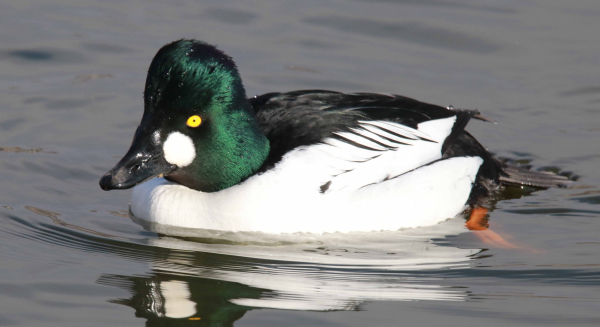
The iridescent feathers that cover the Common Goldeneys’s head add bright color to the pied black and white body colors. Although the sunlight illuminated the duck well, the water remained gray due to the cloud cover directly overhead that reflected on the water surface.
During an especially cold blast of weather with temperatures below zero, but with promise of sunshine throughout the day in central South Dakota, last Thursday I drove south in search of photo opportunities – primarily for eagles, hawks, and falcons – and I made my requisite stop at the most productive “duck pond.” As I approached the east shore, it appeared it was fully ice-covered with Canada and Cackling Geese lying on the snow-covered ice. But as I rounded the south side, I could see 2 drake Common Mergansers and a throng of Mallards in open water along the west side of the pond.
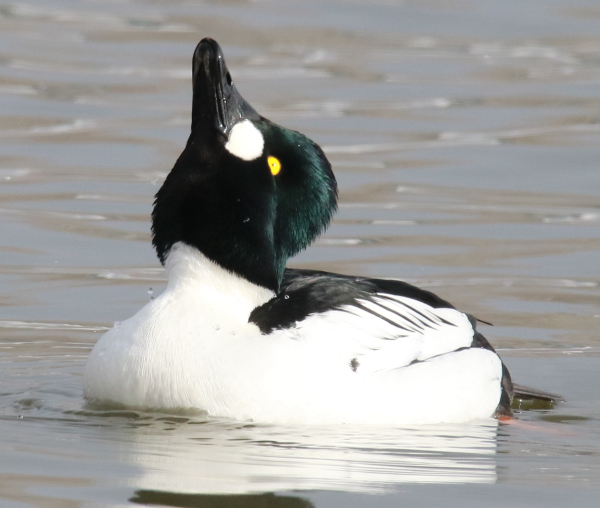
To stop the action of the ducks, an ISO of 400 was used with an f8 aperture, which provided a 1/1250 shutter speed – fast enough to stop the action of the goldeneye’s sky-pointing display.
|
Although the temperature had warmed from –16 to +9, I knew I wouldn’t be outdoors for long. Walking cautiously to a vantage point where I could see a couple more Common Mergansers, and among the many Mallards on hand, I spotted a few distant Common Goldeneyes and Hooded Mergansers. I was most surprised to see the first 4 Canvasbacks I’ve ever seen in this wetland, and as I worked my way along the west side of the pond a male Ring-necked Duck materialized too, and that’s when a foursome of Wood Ducks slipped into view from behind some rocks on the shoreline. The 2 drakes and 2 females were huddled up with their heads pulled in against their backs to conserve heat generated from within.
Suddenly my cold fingers, even within my gloves, didn’t seem so cold anymore, warmed by the promise of photographing the Wood Ducks, the Ring-necked Duck, a Common Goldeneye, Hooded Mergansers, Common Mergansers, and an occasional Mallard. But suddenly I found myself fighting for sunlight as a long cloud materialized. Usually it’s easy enough to wait out a cloud or 2, but it was mighty cold on the water’s edge, and a momentary wisp of a breeze made the situation even colder. I headed back to my vehicle to warm up, hating to leave such great photo potential, but as soon as my face and hands warmed the sun broke through again, and I walked back to the wintering ducks with high hopes.
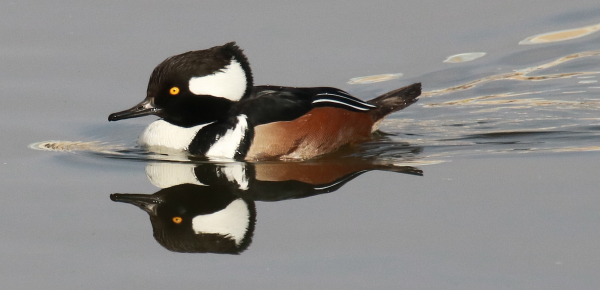
In a windless corner of the pond, an impressive Hooded Merganser cuts through the calm but cold water. In this case the gray background color seems to help to emphasize the colors of the duck and its reflection.
The following half-hour I reveled at the opportunity to photograph the eclectic group of colorful ducks, taking most photos when the birds turned to reflect the full brunt of the early afternoon sunlight, providing shimmering greens, violets, and blues, depending on the species of ducks before me. Although the winter sun was illuminating the ducks in top form, the overhead clouds still reflected gray on the water surface. Even so, the photos I took showing gray water seemed to help “pop” the sun-bright colors of the ducks.
The ducks appeared to be almost as cold as I was and seemed to be conserving their energy, so there wasn’t a lot of opportunities to take action photos; but as always, I worked with what the birds provided, and it was pretty exciting just to be in the presence of such impressive photo subjects. One Common Goldeneye drake was repeatedly performing a sky-pointing display, raising its bill high over its head. Too often though, the displaying goldeneye was facing away from me and the sunlight, making getting a good angle on it challenging, but I did eventually get a nice illustration of it. I was also able to document an interaction between 2 male Hooded Mergansers – always impressive birds to encounter.
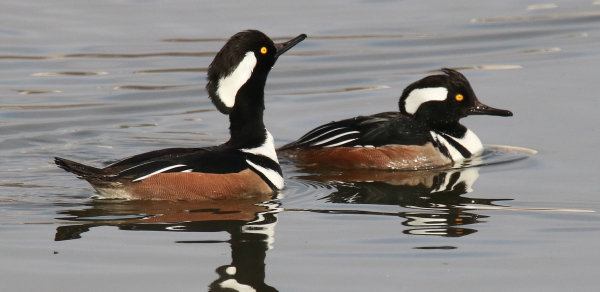
The waterfowl were not very active in the extreme winter temperatures, but an interaction between 2 drake Hooded Mergansers adds some action to this image, which was likewise taken with a shutter speed of 1/1250 of a second.
Some of the most interesting ducks didn’t really provide adequate angles when the sunlight was available, like the Ring-necked Duck that was close at hand throughout most of the photo session, but the images I was able to take of it lacked luster and zest – you know what I mean. The same was true for the female Wood Ducks, which seemed like they were half-asleep most of the time – undoubtedly conserving energy in reaction to the cold. And the big Canvasbacks didn’t even provide an adequate documentary photo.
Even so, now that I know this impressive group of ducks is present, I’m anxious to return and spend more time photographing them – but hopefully it will be a lot warmer with some blue sky action. Where are the waterfowl spending time in your neighborhood, in your region, in your state? It’s always worth planning a winter photo outing, or a series of birding trips. Well, that’s how I finished off my photo exploits for 2021, which was a great year for birding, including photographing birds. I hope 2022 is a great year for you and your camera among a long series of exciting birds from season to season!
Article and photographs by Paul Konrad
Share your bird photos and birding experiences at editorstbw2@gmail.com